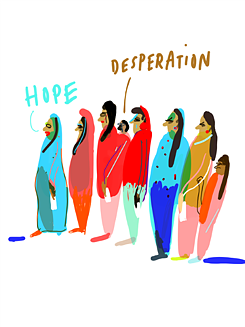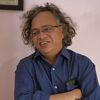14.10.2020 | Naren Bedide
India is the pandemic
India is facing what is probably the worst crisis in her history. Naren Bedide narrates how a dilapidated public health system, massive unemployment, political arrogance and, as if that were not enough, a global pandemic threaten to break down a society that has never been united.
Dear Friends,
A news report published in a leading Indian magazine a few days ago said 78% of patients had to use connections, clout to get a Covid ICU bed. Before coronavirus, over four-fifths of all healthcare expenditure was private: meaning there was no real ‘public’ healthcare system as such. After March, whatever public healthcare institutions which existed were taxed so overmuch that the poor and underprivileged got even more excluded than earlier.
 graphicrecording.cool
The virus carved up India into parts in other ways too. When Maria talks of migrant workers, and how ‘even before the pandemic they effectively had no rights’—that rings so true, and much more intensely in India. The lockdown put more than a third of India’s workforce out of work, hopefully temporarily, and that is a conservative estimate. A significant section of them are inter-state migrant workers.
graphicrecording.cool
The virus carved up India into parts in other ways too. When Maria talks of migrant workers, and how ‘even before the pandemic they effectively had no rights’—that rings so true, and much more intensely in India. The lockdown put more than a third of India’s workforce out of work, hopefully temporarily, and that is a conservative estimate. A significant section of them are inter-state migrant workers.
A majority of these workers were employed on an informal basis, as are over 90% of all workers in India. Mostly daily wagers with no benefits, guarantees or any forms of security. From maids to cooks to various kinds of construction workers to drivers to ushers and watchmen to painters to diamond cutters to waiters to cooks to farm labourers, and a million other kinds of wage slaves. For them, the lockdown was poverty, drought, floods, unemployment, starvation, caste violence and all the other disasters combined and multiplied several times.
The lockdown put more than a third of India’s workforce out of work, hopefully temporarily.
Left with no jobs, savings, and no hope in the immediate future, many migrants started walking home. They walked on foot, because there was no other means of transport: no buses, trains or planes (they couldn’t afford those anyway). Whether home was 500 kilometres away or 1500. So that was how the largest migration in known human history began in March 2020, and continued on foot much until June 2020 (by which time the central government and the state governments approved the operation of some trains and buses). In this period, around 20-40 million people had chosen to walk, according to various estimates.
What happened in the Indian summer of 2020—so many millions of people migrating in such a short span of time—it needs to be reiterated, had never happened earlier. Except for the Partition of India, another time of great carving, in the late 1940s, which involved around 14 million people. The Syrian tragedy is the most recent example, but if these estimates are true, the pandemic has driven more people onto the roads in India.
The most important difference between this exodus and other migrations was that these people were not leaving home, they were trying to get home. Which means they had already migrated once, many of them doing it every year, for seasonal work. If there is inescapable crisis and disaster behind every migration, these migrants knew those enemies quite well, and had learned to live with them.
Their homes, the villages of India, had always been built around a rigid order that sought to control any irruption of the individual. The caste order slots everyone into groups (there are nearly 6,000 castes across India, with 200-500 in each state, on average) and arranges them in a hierarchy with the Brahmin and the landowning castes at the top. All natural resources, including land and water, are allocated according to rank of the particular group, or caste or jati (which literally means birth based group).
Any mobility, upwards, through marriage etc is restricted by the imposition of endogamy, reinforced by class or material differences—between the upper castes and lower castes. The religious ideology woven around purity and pollution also plays a major role in ensuring this. Any lateral movement is equally restricted, through the age old boundaries of endogamy, and curbs on any substantive social interaction.
Marx talked about ‘stagnation’ while Ambedkar, almost a century later, referred to it as a ‘cesspool’. They were both referring to the Indian village, and both meant that social change was very difficult there. The former felt that ‘accumulation’ was impossible there because all surpluses were siphoned away from it (a view which was later challenged to some extent) while Ambedkar felt that the division of labour in the caste order wasn’t just functional division, but it was in fact a ‘division of labourers’ which ensured that all the lower castes couldn’t come together in a struggle to overthrow the ruling castes.
All natural resources, including land and water, are allocated according to rank of the particular group, or caste or jati (which literally means birth based group).
Now, the migrant workers’ migrations (from and to the village) in 2020 offer yet again proof of the truth in Marx’s sharp observations nearly two centuries ago, and Ambedkar’s insights nearly a century ago.
Boosting ‘immunity’ has become a mantra around India and the world in the last few months. If we stretch this idea (of immunity) a little, outside the realm of physical health, and apply it to study Indian society, we’ll find that the threats to it aren’t adventitious, like the pandemic. Its capacity for immunity has long been sapped of any vigour by the caste system. India is the pandemic, and the coronavirus only dents the long enfeebled social health of the subalterns just a bit more.
Nearly a hundred years ago, Dr B. R. Ambedkar told Gandhi, who was fighting for freedom from the British: “Gandhiji, I have no Homeland”. While Gandhi represented the aspirations of the upper strata (upper castes, actually) of Indian society, Ambedkar spoke for the ‘untouchables’ and the other lower castes who constituted the majority of Indians.
The migrants who walked seem to echo Ambedkar’s words, so very emphatically. The migrants are only a small but significant part of how India’s lower caste majority endure their precarious and beleaguered lives. In a hundred years, the majority doesn’t seem to have found a homeland in their own villages. There is so much in the writings of other friends in this debate that strikes a chord, and yet, there seems to be a lot more that doesn’t.
The migrants’ couldn’t boost their immunity at home, where the overall material conditions themselves don’t offer much scope for change, and they couldn’t mobilize it at their workplaces in the cities, beyond a subsistence level. But, the migratory instinct by itself represents a great progress in their lives. So there was change and there wasn’t.
So I don’t fully share Michael’s disappointment with democracy, and other ideals of the west. It was democracy, even of the most rudimentary kind, which revived the impulses for empowerment and improvement in the migrants. To access some public services, to seek basic education at least, to pursue opportunities to better their lives.
 graphicrecording.cool
If the western ideals of democracy and human rights had failed, a lower caste individual like me wouldn’t have found a forum like this to express myself. But their promise remains largely unfulfilled. Hence the migrations, from home and to home.
graphicrecording.cool
If the western ideals of democracy and human rights had failed, a lower caste individual like me wouldn’t have found a forum like this to express myself. But their promise remains largely unfulfilled. Hence the migrations, from home and to home. The debate around democracy overlooks the fact that the non-western ruling classes, especially in countries like India, have more substantially used the technologies of exercising power (that were also born in the west) than the lower classes have been able to use the tools of rights.
Here, we need to examine the last major way in which the pandemic divided India, again using the framework of the lockdown and the consequent migrations. The migrants were majorly from the northern and the eastern states, to an extent, while their places of work were in the western and southern states. The latter offered opportunities for work because they were wealthier, relatively, and offered better wages and economic opportunities. For instance, on average, per capita incomes in the destination states were 3 to 6 times higher than in the migrant workers’ home states. Like elsewhere in the world, economics played a great part in the migrations.
But there was another vital difference between the home states and the destination states which isn’t captured fully by using only economic measures. The home states lag behind, significantly, on all human development indices: literacy, child and maternal health, sex ratios etc. And the destination states were all more urbanized and industrialized. Above all, the key difference was linguistic: most of the migrants came from Hindi speaking states originally, while the destination states spoke various older languages. Much older languages, in fact, with cultures and histories of their own, which overlapped only to a limited extent during British and Mughal empires etc.
Therefore, the migrants were in all senses, except the nominal criterion of citizenship, refugees as much as any Afghans in Pakistan or Somalis in Yemen. The cultural, socio-economic, historic differences between these migrants and the people in the destination and host states are perhaps greater than those between, say, Syria and Europe, and Colombia and the United States, etc.
While their first migration, from home to the host state, was actuated by economic stagnation made worse by caste rigidity, the migration in reverse was necessitated by cost conscious capitalism. While the state governments and civil society groups made some efforts to provide some relief to the migrant workers, the cultural differences became the most important factor again, impelling the refugees’ decision to walk back home.
Concerted collective protests on their part, demanding their rights and challenging their irresponsible employers wasn’t possible because such actions on their part would have required understanding and assimilation of their concerns by the local working class. As Ambedkar pointed out, that wasn’t possible in a caste society. Especially so when a particular caste society speaks in a language, tone and logic completely different from the caste society at home.
What this pandemic has revealed is the utter powerlessness of the Indian Bahujan (lower caste majority), at home and in their host states. Their ability to attract and hold the attention of government structures or in any significant way influence social action or discourse has always been limited by the traditional social order informed by caste, and at a pan-India level, by lack of a broad cultural unity.
If the Bahujans manage to assert their right at the village level, and tilt the caste order, that would be undone at the district level; if they overcome even that, they’d definitely be rebuffed at the state level. If they pass through that stage, the central (or federal government) would work to restore the social order. Meaning, little successes in tilting the balance of power (always in favour of the dominant castes, whose strength grows at every new rung in the hierarchy of authority) in a few places would always be short lived. That’s how the union of India works against the Bahujans’ collective immune system.
One is again reminded of what Ambedkar said:
‘Men constitute a society because they have things which they possess in common. To have similar things is totally different from possessing things in common. And the only way by which men can come to possess things in common with one another is by being in communication with one another. This is merely another way of saying that Society continues to exist by communication—indeed, in communication. To make it concrete, it is not enough if men act in a way which agrees with the acts of others. Parallel activity, even if similar, is not sufficient to bind men into a society.’
Indians of different regions or states have always engaged in parallel activities, many times dissimilar (now contradictory) and were never one society. So the national parties like the Congress had always practiced different kinds of populism in different regions, and called it ‘unity in diversity’. Now the BJP has usurped their mantle and shed all pretenses of catering to diverse populations, insisting everyone is a Hindu (including Muslims, Christians and Sikhs) or should learn to be Hindu, because that is the timeless truth of India. It wants to bring in an older mode of populism. That’s where I differ with Youssef.
This has been perhaps one of the saddest years of my life, seeing such misery closely, and from a distance. Those millions walking in the harshest Indian sun, and during nights. Men, women and children with their belongings wrapped in sarees or plastic bags or cheap suitcases. One girl rode 1200 km on a bicycle with her wounded father. One traveler died just a few meters from home, another a few miles. They starved, and starved. The largest selling item of food was a brand of inexpensive biscuits—that was all they could mostly afford.
There was no way I could move away from the virus, take thoughts away. To exorcise it, I feel, one has to look at all the world around it through its eyes, maybe.
Rich relatives died, poor relatives also got affected. There wasn’t a hospital that would take in the former despite wads of cash, the latter trying to cling to the hope that their children or spouses wouldn’t be touched by the virus, so there would be no need for unaffordable tests for them even if they were all living in the same home.
[...] national parties like the Congress had always practiced different kinds of populism in different regions, and called it ‘unity in diversity’. Now the BJP has usurped their mantle and shed all pretenses of catering to diverse populations, insisting everyone is a Hindu (including Muslims, Christians and Sikhs) or should learn to be Hindu, because that is the timeless truth of India.
People couldn’t afford funeral ceremonies for their dear ones. Dead bodies went missing, patients lay unattended on pavements. And the governments in most states used the civil inactivity during the lockdown to clamp down much harder on all kinds of dissenters.
But one has to still insist India is the pandemic. The only way to fight it is to reclaim one’s immunity at your home village.
